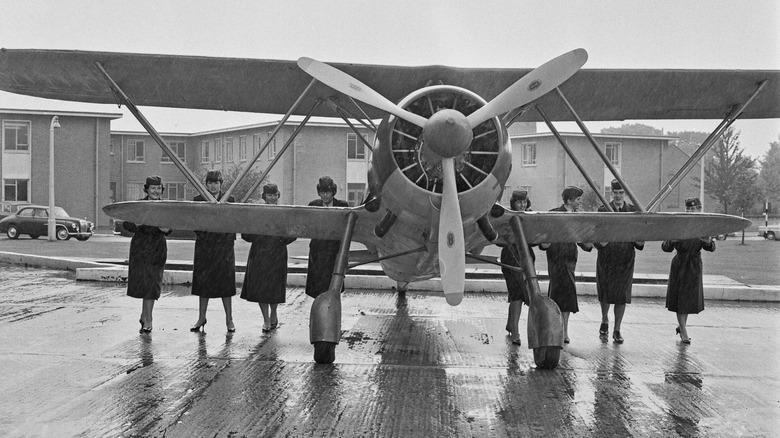Why Italy's Fiat CR.42 Falco Jet Quickly Fell Behind In WW2
The first thing that probably comes to mind about Fiat is its diminutive automobile, not a biplane used during World War II. Despite that clash of imagery, Fiat did indeed build fighter planes, one of which was flown by Italy's Royal Italian Air Force when World War II kicked off.
Italian aeronautics engineer Celestino Rosatelli was behind Fiat's CR.42 Falco, or "Falcon." The "CR" line, which stands for Caccia Rosatelli ("caccia" means "hunting" in Italian), were all fighter planes. He is credited with designing over 50 aircraft, 40 of which were eventually built, including the "BR" bombers. Rosatelli firmly believed a biplane could be successful despite the move in aeronautical technology away from it as long as it had a powerful enough engine and the proper aerodynamics.
Historians consider the Falco the "best biplane in service in 1940," which is like saying the Model T was the best hand-cranked car on the track at the Indianapolis 500 in 2023. This isn't meant to mock Fiat's efforts, especially given the grit and determination needed in the face of yet another world war. Still, when 1939 rolled around, single fixed-wing fighters like Britain's Hawker Hurricane (introduced in 1937), Supermarine Spitfire (1938), and Germany's Messerschmitt Me 109 (1937) ruled the air.
The fighting Falco was an underpowered, barely armed replacement
Powered by a Fiat A.74 RC38 14-cylinder radial engine producing 840 horsepower, the Falco could reach a top speed of 274 mph. However, that's not impressive compared to the Hurricane's top speed of 340, the Messerschmitt's nearly 350, or the Spitfire's blazing 408 mph. Still, a one-off version (CR.42DB) was built that reached 323 mph and still holds the Guinness record for being the fastest biplane ever.
Despite the obvious obsolescence of biplanes, Rosatelli pressed on, but with some advanced aerodynamic tweaks. The Falco's lower wing was less than half the surface area and thus much smaller than the upper wing. This sesquiplane variation helped make it nimble and incredibly difficult to hit.
A few other questionable "tweaks" went into the design, though. The plane was light, with an empty weight of fewer than 4,000 pounds. But that was accomplished by excluding things like armor or a working radio, so there was no way for pilots to communicate or coordinate attacks.
Additionally, early versions were armed with only two forward-facing Breda SAFAT machine guns. These were great against WWI's wood and canvas-covered planes but not so much against the armor and metal found on the newest fighter craft.
Rosatelli wasn't entirely wrong about the Falco — 1,819 were built between 1939 and 1944. While Italy used the majority, other countries such as Croatia, Germany, Hungary, Sweden, Belgium, and Spain also flew them. The very last biplane victory may have been when a Luftwaffe-piloted Falco shot down a P-38 Lightning over Croatia in February 1945. Only four are known to have survived.
